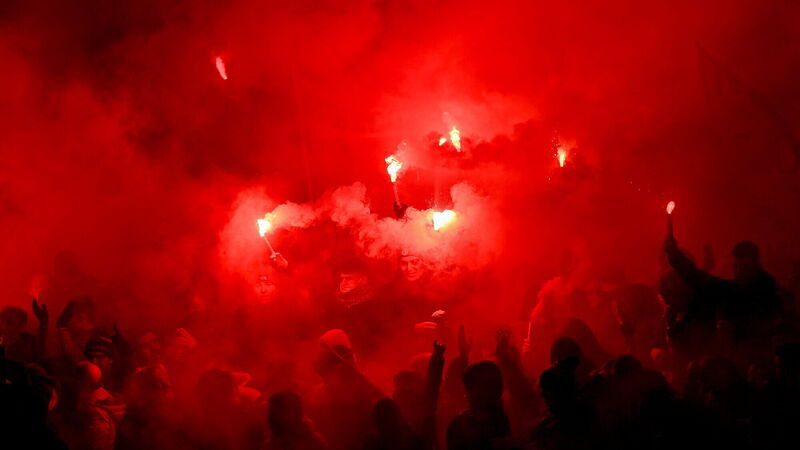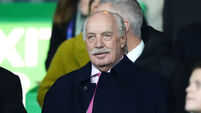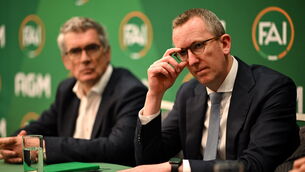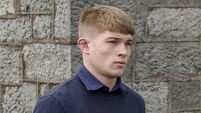Tommy Martin: Was FAI Cup final the start of something special or just a big day out?

Bohemians supporters light flares during the FAI Cup final against St Patrick’s Athletic at the Aviva Stadium. Picture: Seb Daly
You’ve walked into the Aviva Stadium many times but you’ve never walked into it like it was coming up to four o’clock last Sunday.
Flashing disco lights burned through thick flare smoke, illuminating multi-coloured clouds billowing out from either end of the ground. Metallica’s ‘Enter Sandman’ chugged out from the speakers into the primordial haze and the teams emerged into the fog like they should have been riding on winged horses.
This was less Pats against Bohs, more the dawn of time as imagined by Ozzy Osbourne.
The moments before the FAI Cup final had a dreamlike quality because cup final day is Irish soccer’s time to dream. Unlike cup finals elsewhere, Ireland’s big day still feels like a big day. A day to get dressed up and act like a swell, to pretend a little, to imagine what it would be like if it was always like this.
As the smoke cleared and a football match broke out you saw the shape of the dream. Packed trains and buses ferrying boisterous bands singing their songs loyal and profane. Thousands milling through the capital’s streets on their way to the match and the match owning the city. A crowd, loud and proud, in five figures, watching two Irish teams play in the luxury of a modern stadium.
This wasn’t domestic football as cult curiosity. There was no bellyaching about barstoolers or blazers. This was about tearing off the working clothes, putting on some lippy and looking like a star. This was the big dance.
They put the final in the Aviva Stadium and the people came: the fourth time it had drawn more than 30,000 since the Ballsbridge bed pan opened in 2010. Last Sunday was the biggest crowd for a final since 39,000-odd crammed into Dalymount in 1968 to watch Shamrock Rovers beat Waterford in black and white.
What does it all mean? All the people and the noise and the power chords and smoky atmospherics? Are the new hordes of cup final day a swelling chorus chanting for Irish football to come out of the shadowlands? Is it all part of the wider aspirational narrative that yearns for something authentic and homegrown and takes in the national teams and how they go about their business too?
Or is just a big day out? Just because a man dresses up in a green hat and a fake beard on March 17, does it mean he wants to be a 5th century Welsh bishop?
The game took on the flat, stilted nature finals often do, as if the players still think they are wearing their cup final suits. The pitch and the occasion told on the legs in a way that puts you in mind of FA Cup Finals of the 1970s and 1980s, which were decided when one of the few players not suffering from cramp would stagger across the Wembley acres and exhaustedly poke home the winner.
For many, it is in this retro flavour that much of the League of Ireland’s charm resides. The players remain accessible everymen. The grounds offer intimacy if not always comfort, economy if not always convenience. If the values of elite football have been dissolved by financial excess, at least that’s one problem the League of Ireland doesn’t have. It is cherished for being ‘real football’. Maybe that’s why cup final day feels like a dream.
What about the carry-on in Irishtown? A bunch of thugs set upon a gathering of fans from the other side for no apparent reason other than to act out some pantomime hooligan choreography. They numbered a fraction of a percentage of the thousands who were part of the day. Are they even worth talking about? Do they mean anything?
If they do, it is as part of a greater sense of Irish football trying to figure itself out. As much as the big day at the Aviva is a chance for the peasant to wear the clothes of an emperor, so the flares and chants and banners that give a League of Ireland occasion its atmosphere can sometimes feel like juvenile ultra cosplay. The lads in Irishtown were a bad batch but it’s a strong cocktail at the best of times.
Still, leaving the Aviva Stadium on Sunday evening you were struck by the way the currents of fans flowed by each other in tolerant disregard. Pats voices roared the gloating songs of victory, Bohs heads dipped, no stopping till Phibsborough. But they did not clash and fizzle like poles of opposite feeling should.
It was a man’s crowd, mostly, with the latent aggression that usually means. But it was the sort of crowd that, were Damien Dempsey to suddenly appear with a guitar singing songs of sweaty defiance, might suddenly take to hugging each other. It felt like a defused masculinity, like an old rusty nuclear bomb casing that someone had converted into a flowerbed.
After the cup final, the dream ends and the clubs get on with things. Players who are heroes one day are often free agents the next. Small bands of administrators and volunteers sort out budgets and licences and comings and goings; fundraising and grant applications to fix up the grounds or make them anew. Could you track down and deal with the Irishtown miscreants while you’re at it?
Then there’s the post-Brexit reckoning that means it is also their job to rear the next generation of players in hastily constructed and under-resourced academies.
If there is a collective desire within Irish people for their football to be bigger and better, to be something like the dream of cup final day all year round, it feels like a lot of heavy lifting for the factory floor.
Packie Bonner was out the other week with an FAI report that shows how much return the taxpayer gets from Irish football in economic and wellbeing terms.
The figure they came up with was €1.8bn. It was a way of nudging the public and private sectors to help fund some of the lofty aspirational stuff.
Even half of the €96m the horse and greyhound industry got this year, that would be grand.
Who ever said dreams were supposed to make sense?

Unlimited access. Half the price.
Try unlimited access from only €1.50 a week
Already a subscriber? Sign in








